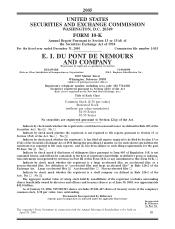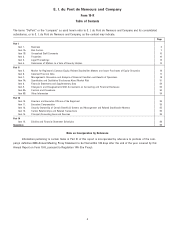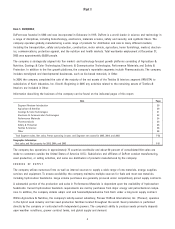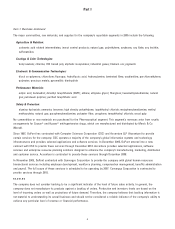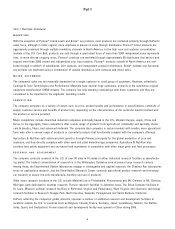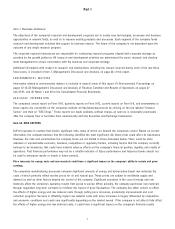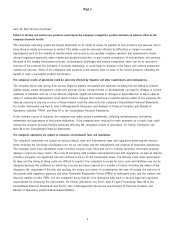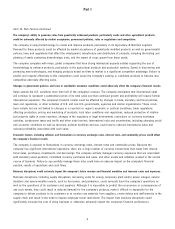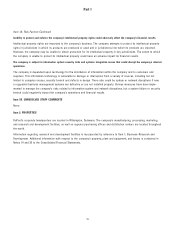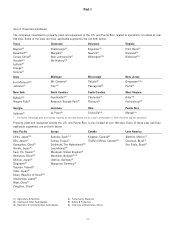DuPont 2005 Annual Report Download - page 9
Download and view the complete annual report
Please find page 9 of the 2005 DuPont annual report below. You can navigate through the pages in the report by either clicking on the pages listed below, or by using the keyword search tool below to find specific information within the annual report.Part I
Item 1A. Risk Factors–Continued
The company’s ability to generate sales from genetically enhanced products, particularly seeds and other agricultural products,
could be adversely affected by market acceptance, government policies, rules or regulations and competition.
The company is using biotechnology to create and improve products, particularly in its Agriculture & Nutrition segment.
Demand for these products could be affected by market acceptance of genetically modified products as well as governmental
policies, laws and regulations that affect the development, manufacture and distribution of products, including the testing and
planting of seeds containing biotechnology traits, and the import of crops grown from those seeds.
The company competes with major, global companies that have strong intellectual property estates supporting the use of
biotechnology to enhance products, particularly in the agricultural products and production markets. Speed in discovering and
protecting new technologies, and bringing products based on them to market is a significant competitive advantage. Failure to
predict and respond effectively to this competition could cause the company’s existing or candidate products to become less
competitive adversely affecting sales.
Changes in government policies and laws or worldwide economic conditions could adversely affect the company’s financial results.
Sales outside the U.S. constitute more than half of the company’s revenue. The company anticipates that international sales
will continue to represent a substantial portion of its total sales and that continued growth and profitability will require further
international expansion. The company’s financial results could be affected by changes in trade, monetary and fiscal policies,
laws and regulations, or other activities of U.S. and non-U.S. governments, agencies and similar organizations. These condi-
tions include but are not limited to changes in a country’s or region’s economic or political conditions, trade regulations
affecting production, pricing and marketing of products, local labor conditions and regulations, reduced protection of intellec-
tual property rights in some countries, changes in the regulatory or legal environment, restrictions on currency exchange
activities, burdensome taxes and tariffs and other trade barriers. International risks and uncertainties, including changing social
and economic conditions as well as terrorism, political hostilities and war, could lead to reduced international sales and
reduced profitability associated with such sales.
Economic factors, including inflation and fluctuations in currency exchange rates, interest rates, and commodity prices could affect
the company’s financial results.
The company is exposed to fluctuations in currency exchange rates, interest rates and commodity prices. Because the
company has significant international operations, there are a large number of currency transactions that result from interna-
tional sales, purchases, investments, and borrowings. The company actively manages currency exposures that are associated
with monetary asset positions, committed currency purchases and sales, and other assets and liabilities created in the normal
course of business. Failure to successfully manage these risks could have an adverse impact on the company’s financial
position, results of operations and cash flows.
Business disruptions could seriously impact the company’s future revenue and financial condition and increase costs and expenses.
Business disruptions, including supply disruptions, increasing costs for energy, temporary plant and/or power outages, natural
disasters and severe weather events, such as hurricanes, and pandemics, could seriously harm the company’s operations as
well as the operations of its customers and suppliers. Although it is impossible to predict the occurrences or consequences of
any such events, they could result in reduced demand for the company’s products, make it difficult or impossible for the
company to deliver products to its customers or to receive raw materials from suppliers, create delays and inefficiencies in the
supply chain and result in the need to impose employee travel restrictions. The impact from business disruptions could
significantly increase the cost of doing business or otherwise adversely impact the company’s financial performance.
9

